Sarah L. Johnson's Blog, page 133
February 6, 2012
Guest post from Margaret Wurtele, author of The Golden Hour
Today Margaret Wurtele is stopping by with a guest post about using diaries and memoirs as background material. Her debut novel, The Golden Hour, takes place in Italy during World War II. I'm happy to have the opportunity to feature her here, as I enjoyed her book very much when I reviewed it last month.
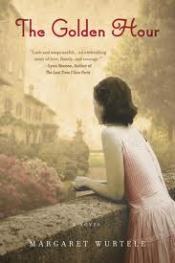 When Nazi soldiers take over their villa, 17-year-old Giovanna Bellini and her parents must relocate to five small rooms in the back of the house. It's 1944, and after Italy makes peace with the Allies, Tuscany is overrun by German occupiers. This smoothly written debut presents Giovanna's coming-of-age as she breaks away from her family's protectiveness and finds a noble calling in aiding Italy's partisan fighters, including her brother, Giorgio.
When Nazi soldiers take over their villa, 17-year-old Giovanna Bellini and her parents must relocate to five small rooms in the back of the house. It's 1944, and after Italy makes peace with the Allies, Tuscany is overrun by German occupiers. This smoothly written debut presents Giovanna's coming-of-age as she breaks away from her family's protectiveness and finds a noble calling in aiding Italy's partisan fighters, including her brother, Giorgio.
Wurtele captures the innocence and impetuousness of youth as Giovanna explores her attraction to a handsome Nazi lieutenant and later falls in love with Mario, a Jewish man who was badly wounded in the resistance movement. While she risks her life to keep Mario safe, her stubborn father veers between his original Fascist loyalties and his hopes for an Allied victory.
The novel is narrated by an older, wiser Giovanna, and her periodic commentary on the dangerous situations unnoticed by her younger self contributes to the suspense. Wurtele carefully looks beyond religious and cultural stereotypes, and her heroine's character growth is moving and realistic. (Review first published in the January 1st issue of Booklist)
The Golden Hour will officially be published by NAL tomorrow ($15.00, trade pb, 320pp).
~
From Margaret Wurtele:
When I think of the phrase "reading the past," it occurs to me how important diaries, journals and memoirs are to us, as readers and as writers. My novel The Golden Hour was originally sparked on a visit to Italy about six years ago. At lunch on the grounds of a Tuscan villa near Lucca, our host recounted a fragment of his family history that lodged in my head and would not let go. My character, the young Giovanna, was born that afternoon, when I was introduced to our host's mother, then in her 80s. As I wrote, in the years following that brief encounter, the story evolved and changed, becoming my story, not theirs.
When I began to research World War II in Italy, I found all sorts of narratives of the war, military chronicles, and descriptions of life in Italy in the early forties – all fact-filled and a bit dry. But what truly drew me in and excited my imagination were first-person narratives – journals, diaries and memoirs rooted both in the time and place of my story.
I discovered, for example, Iris Origo's absorbing War in Val d'Orcia: An Italian War Diary. This erudite Anglo-America woman, living on the opposite side of the Italian peninsula from Lucca, wrote vividly about operating a shelter on the grounds of her estate for refugee children, protecting them from the ravages of war. Her courage and generous spirit moved me, and she became the inspiration for my own character, Marchesa Lily Falconieri.
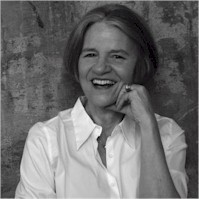 Another first-person account provided me with precious details of both time and place. Tullio Bruno Bertini's Trapped in Tuscany is a memoir written by an American, the son of Italian immigrants. At nine years old, attempting to repatriate to their home country, his family found themselves trapped in northern Italy under German occupation. They spent the years of the war in Diecimo, a small village in the Serchio River valley, a few kilometers from where my novel is set. From him I got a feel for the hardships of the occupation, for the sequence of the Allies' liberation of the area, for the details of day-to-day village life in those difficult times.
Another first-person account provided me with precious details of both time and place. Tullio Bruno Bertini's Trapped in Tuscany is a memoir written by an American, the son of Italian immigrants. At nine years old, attempting to repatriate to their home country, his family found themselves trapped in northern Italy under German occupation. They spent the years of the war in Diecimo, a small village in the Serchio River valley, a few kilometers from where my novel is set. From him I got a feel for the hardships of the occupation, for the sequence of the Allies' liberation of the area, for the details of day-to-day village life in those difficult times.
In Italy I found a copy of A Farm in Chianti by Maria Bianca Viviani della Robbia. It is an enthralling memoir, written a decade or so after World War II, that offered a rich and colorful description of the rural Tuscan landscape. Though much of the sense of place in The Golden Hour was informed by my own life in the vineyards and olive groves of California's Napa Valley, this Chianti-based journal grounded me in the particulars of Tuscan agricultural life.
The Golden Hour is my first novel, but both of my earlier published memoirs drew almost exclusively on my own journals for their raw material. Taking Root is both a gardening journal and a year of spiritual reflection that chronicles an awakening in my early forties. Touching the Edge, a reflection on my son's death on Mount Rainier, was written a couple of years after his accident, but it drew upon the raw immediacy of three volumes of diaries in which I originally recorded my horrific loss.
I, like so many people, have always kept journals, ever since I was in high school – some years more actively than others. Will all of our private notations and confidences, this accumulation of worn paper and stained leather, I wonder, be relegated to the trash heap? Or might a page or two some day be unearthed and become a source of inspiration for a 22nd century historical novel?
~
Margaret Wurtele is the author of two memoirs. She and her husband split their time between Minnesota and Napa Valley, where they are owners of Terra Valentine Winery. Visit her online at www.margaretwurtele.com.
 When Nazi soldiers take over their villa, 17-year-old Giovanna Bellini and her parents must relocate to five small rooms in the back of the house. It's 1944, and after Italy makes peace with the Allies, Tuscany is overrun by German occupiers. This smoothly written debut presents Giovanna's coming-of-age as she breaks away from her family's protectiveness and finds a noble calling in aiding Italy's partisan fighters, including her brother, Giorgio.
When Nazi soldiers take over their villa, 17-year-old Giovanna Bellini and her parents must relocate to five small rooms in the back of the house. It's 1944, and after Italy makes peace with the Allies, Tuscany is overrun by German occupiers. This smoothly written debut presents Giovanna's coming-of-age as she breaks away from her family's protectiveness and finds a noble calling in aiding Italy's partisan fighters, including her brother, Giorgio.Wurtele captures the innocence and impetuousness of youth as Giovanna explores her attraction to a handsome Nazi lieutenant and later falls in love with Mario, a Jewish man who was badly wounded in the resistance movement. While she risks her life to keep Mario safe, her stubborn father veers between his original Fascist loyalties and his hopes for an Allied victory.
The novel is narrated by an older, wiser Giovanna, and her periodic commentary on the dangerous situations unnoticed by her younger self contributes to the suspense. Wurtele carefully looks beyond religious and cultural stereotypes, and her heroine's character growth is moving and realistic. (Review first published in the January 1st issue of Booklist)
The Golden Hour will officially be published by NAL tomorrow ($15.00, trade pb, 320pp).
~
From Margaret Wurtele:
When I think of the phrase "reading the past," it occurs to me how important diaries, journals and memoirs are to us, as readers and as writers. My novel The Golden Hour was originally sparked on a visit to Italy about six years ago. At lunch on the grounds of a Tuscan villa near Lucca, our host recounted a fragment of his family history that lodged in my head and would not let go. My character, the young Giovanna, was born that afternoon, when I was introduced to our host's mother, then in her 80s. As I wrote, in the years following that brief encounter, the story evolved and changed, becoming my story, not theirs.
When I began to research World War II in Italy, I found all sorts of narratives of the war, military chronicles, and descriptions of life in Italy in the early forties – all fact-filled and a bit dry. But what truly drew me in and excited my imagination were first-person narratives – journals, diaries and memoirs rooted both in the time and place of my story.
I discovered, for example, Iris Origo's absorbing War in Val d'Orcia: An Italian War Diary. This erudite Anglo-America woman, living on the opposite side of the Italian peninsula from Lucca, wrote vividly about operating a shelter on the grounds of her estate for refugee children, protecting them from the ravages of war. Her courage and generous spirit moved me, and she became the inspiration for my own character, Marchesa Lily Falconieri.
 Another first-person account provided me with precious details of both time and place. Tullio Bruno Bertini's Trapped in Tuscany is a memoir written by an American, the son of Italian immigrants. At nine years old, attempting to repatriate to their home country, his family found themselves trapped in northern Italy under German occupation. They spent the years of the war in Diecimo, a small village in the Serchio River valley, a few kilometers from where my novel is set. From him I got a feel for the hardships of the occupation, for the sequence of the Allies' liberation of the area, for the details of day-to-day village life in those difficult times.
Another first-person account provided me with precious details of both time and place. Tullio Bruno Bertini's Trapped in Tuscany is a memoir written by an American, the son of Italian immigrants. At nine years old, attempting to repatriate to their home country, his family found themselves trapped in northern Italy under German occupation. They spent the years of the war in Diecimo, a small village in the Serchio River valley, a few kilometers from where my novel is set. From him I got a feel for the hardships of the occupation, for the sequence of the Allies' liberation of the area, for the details of day-to-day village life in those difficult times.In Italy I found a copy of A Farm in Chianti by Maria Bianca Viviani della Robbia. It is an enthralling memoir, written a decade or so after World War II, that offered a rich and colorful description of the rural Tuscan landscape. Though much of the sense of place in The Golden Hour was informed by my own life in the vineyards and olive groves of California's Napa Valley, this Chianti-based journal grounded me in the particulars of Tuscan agricultural life.
The Golden Hour is my first novel, but both of my earlier published memoirs drew almost exclusively on my own journals for their raw material. Taking Root is both a gardening journal and a year of spiritual reflection that chronicles an awakening in my early forties. Touching the Edge, a reflection on my son's death on Mount Rainier, was written a couple of years after his accident, but it drew upon the raw immediacy of three volumes of diaries in which I originally recorded my horrific loss.
I, like so many people, have always kept journals, ever since I was in high school – some years more actively than others. Will all of our private notations and confidences, this accumulation of worn paper and stained leather, I wonder, be relegated to the trash heap? Or might a page or two some day be unearthed and become a source of inspiration for a 22nd century historical novel?
~
Margaret Wurtele is the author of two memoirs. She and her husband split their time between Minnesota and Napa Valley, where they are owners of Terra Valentine Winery. Visit her online at www.margaretwurtele.com.
Published on February 06, 2012 04:00
January 31, 2012
A visual preview of the spring season
Here we are again with another collage of historical novel covers and descriptions. As usual, I'm running slightly behind, which means a summer preview will be posted very soon. In alphabetical order by author, below, are previews for 15 novels set to appear between February and May 2012, chosen out of personal interest. Realistically speaking, I'll only get to a fraction of these in the immediate future, although I don't like to admit it. I want to read them all.
In addition to these, the Historical Novel Society's forthcoming books page lists titles set to be published between now and August. I'll be reviewing yet more spring titles here, later - stay tuned!
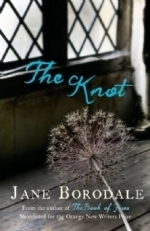
Jane Borodale's excellent Book of Fires, about a young woman, pregnancy, and pyrotechny in 1750s London, was the first book I reviewed in 2010. The Knot steps back two centuries and continues its focus on ordinary people from English history. In its story of one man's life, it looks at love, gardening, and the translation of an Herbal in rural Somerset during the Elizabethan era.
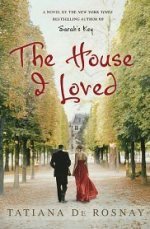
I am undoubtedly one of the few people who hasn't read Sarah's Key; I've read quite a bit of fiction about World War II lately, but not that one. (You all can tell me if I'm missing anything.) De Rosnay's third novel in English takes place in 1860s Paris as a woman fights to save her beloved family home from destruction during the city's renovation. St. Martin's, Feb.
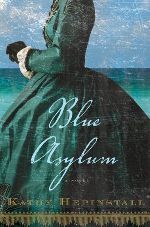
There's nothing like the premise of Blue Asylum to make women grateful that they're living in the 21st century. During the Civil War, a Southern plantation owner's wife is put away in a mental hospital for daring to express abolitionist tendencies. The story doesn't end there, of course. HMH, April.
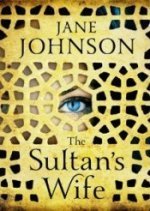
I enjoyed Johnson's The Salt Road (it of the gorgeous UK cover) well enough to want to pick up her third mainstream historical, this one moving from 17th-century Morocco to the more familiar court of England's Charles II. Viking UK and Doubleday Canada, Feb.
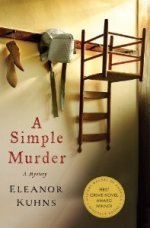
A murder mystery set in an 18th-century Shaker community? That seems like such an incongruous notion that despite the title, I doubt there's anything simple about this storyline. Eleanor Kuhns' A Simple Murder, taking place in 1796 Maine, was the winner of Mystery Writers of America's First Crime Novel Competition, and the author is a librarian in upstate New York. Minotaur, May.
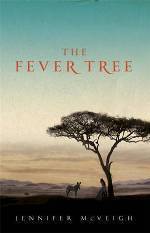
I posted the US publishing deal for this title last March (it's forthcoming from Amy Einhorn Books, who also published The Help and Sarah Blake's The Postmistress, among others, so we'll be hearing plenty more about it). I've been looking forward to it since. Americans will have to wait a bit, as this is the UK edition. As you might guess from the spectacular cover, it takes place in Africa: the diamond fields of 1870s South Africa, to be specific. A self-involved young Englishwoman arrives there to marry an ambitious doctor and joins him on his smallpox station on the isolated Karoo plains, where she gets caught up in local drama. Viking UK, March.
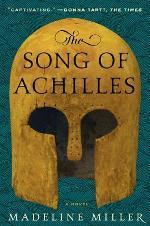
The Song of Achilles has been out in the UK since the autumn, and reviews have been outstanding overall. An epic of love, war, and fate in ancient Greece and a retelling of events from Homer's Iliad, it focuses on the growing relationship between Patroclus and Achilles. The legendary warrior from the Trojan War is depicted here as a romantic hero. Ecco, March.
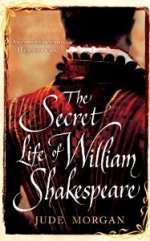
You all may be weary of my singing Jude Morgan's praises by now, but I couldn't resist posting the cover of his soon-to-be-released biographical novel about the Bard. I've read many novels about Shakespeare, but have high hopes that this one will show a new side to his character. Morgan specializes in insightful fictional portraits of famously creative men and women from history, and I expect no less from this volume. Headline, April.
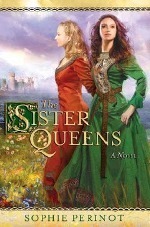
Sophie Perinot's debut novel centers on two royal women you won't have read much about before in fiction: Marguerite of Provence, who married Louis IX of France, and Eleanor of Provence, who married England's Henry III. Sisters, close friends, and occasional rivals, their relationship endures despite the distance that separates them for most of their long lives. For my fellow chunksterers: this one will count too. NAL, March.
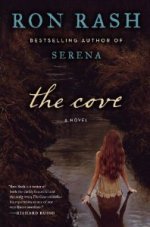
This gothic-tinged cover is so different from the pastoral scene that appeared on the ARC that I did a double take. As with his previous novel, Serena (see news on the film version), we're back in the dark, gorgeous landscape of early 20th-century Appalachia. A novel about a mysterious stranger, a woman thought to be a witch, and a secret with dangerous repercussions in WWI-era North Carolina. Ecco, April.
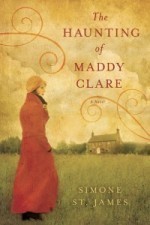
Gothic romantic suspense (with ghosts) set in an England already haunted by war... sounds like my type of book. In the years after World War I, a young woman is charged with helping a ghost-hunter dispel the angry spirit of Maddy Clare, who died by suicide. NAL, March.
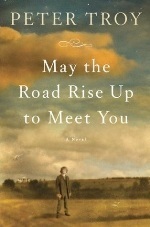
A saga about immigration to America in the mid-19th century; not an uncommon subject, but what makes this one different is the author's choice to tell it in the voices of four characters with very different cultural perspectives: a young Irishman, a Spanish society girl, and a man and a woman who are slaves. The American Civil War forms the eventual backdrop to their stories. Doubleday, March.
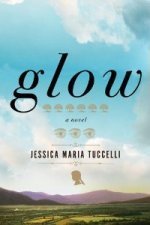
Here we have a saga of a different sort, one that explores the bonds between mothers and daughters over a century, from the 1830s to the World War II years, in the mountains of rural north Georgia. The ongoing evolution (or not) of race relations involving African Americans and the Cherokee weaves in and out of the tale, along with elements of magical realism. Viking, March.
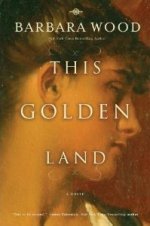
Turner Publishing has been around for a while, per their website, but they're new to me... and they've been buying up a number of novels from Barbara Wood's backlist, as well as some newer titles. Wood is one of the rare historical novelists who can adapt her skills to numerous settings and eras. This Golden Land is a saga about a female healer who travels from 19th-century England to Melbourne to pursue her calling as a midwife. (Per Amazon, it was previously published with iUniverse.) Turner, May.
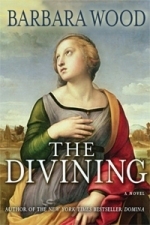
And one more by Wood with the same release date (and an awesome cover): The story of a Germanic-Roman woman with second sight during Christianity's early years. Turner, May.
In addition to these, the Historical Novel Society's forthcoming books page lists titles set to be published between now and August. I'll be reviewing yet more spring titles here, later - stay tuned!

Jane Borodale's excellent Book of Fires, about a young woman, pregnancy, and pyrotechny in 1750s London, was the first book I reviewed in 2010. The Knot steps back two centuries and continues its focus on ordinary people from English history. In its story of one man's life, it looks at love, gardening, and the translation of an Herbal in rural Somerset during the Elizabethan era.

I am undoubtedly one of the few people who hasn't read Sarah's Key; I've read quite a bit of fiction about World War II lately, but not that one. (You all can tell me if I'm missing anything.) De Rosnay's third novel in English takes place in 1860s Paris as a woman fights to save her beloved family home from destruction during the city's renovation. St. Martin's, Feb.

There's nothing like the premise of Blue Asylum to make women grateful that they're living in the 21st century. During the Civil War, a Southern plantation owner's wife is put away in a mental hospital for daring to express abolitionist tendencies. The story doesn't end there, of course. HMH, April.

I enjoyed Johnson's The Salt Road (it of the gorgeous UK cover) well enough to want to pick up her third mainstream historical, this one moving from 17th-century Morocco to the more familiar court of England's Charles II. Viking UK and Doubleday Canada, Feb.

A murder mystery set in an 18th-century Shaker community? That seems like such an incongruous notion that despite the title, I doubt there's anything simple about this storyline. Eleanor Kuhns' A Simple Murder, taking place in 1796 Maine, was the winner of Mystery Writers of America's First Crime Novel Competition, and the author is a librarian in upstate New York. Minotaur, May.

I posted the US publishing deal for this title last March (it's forthcoming from Amy Einhorn Books, who also published The Help and Sarah Blake's The Postmistress, among others, so we'll be hearing plenty more about it). I've been looking forward to it since. Americans will have to wait a bit, as this is the UK edition. As you might guess from the spectacular cover, it takes place in Africa: the diamond fields of 1870s South Africa, to be specific. A self-involved young Englishwoman arrives there to marry an ambitious doctor and joins him on his smallpox station on the isolated Karoo plains, where she gets caught up in local drama. Viking UK, March.

The Song of Achilles has been out in the UK since the autumn, and reviews have been outstanding overall. An epic of love, war, and fate in ancient Greece and a retelling of events from Homer's Iliad, it focuses on the growing relationship between Patroclus and Achilles. The legendary warrior from the Trojan War is depicted here as a romantic hero. Ecco, March.

You all may be weary of my singing Jude Morgan's praises by now, but I couldn't resist posting the cover of his soon-to-be-released biographical novel about the Bard. I've read many novels about Shakespeare, but have high hopes that this one will show a new side to his character. Morgan specializes in insightful fictional portraits of famously creative men and women from history, and I expect no less from this volume. Headline, April.

Sophie Perinot's debut novel centers on two royal women you won't have read much about before in fiction: Marguerite of Provence, who married Louis IX of France, and Eleanor of Provence, who married England's Henry III. Sisters, close friends, and occasional rivals, their relationship endures despite the distance that separates them for most of their long lives. For my fellow chunksterers: this one will count too. NAL, March.

This gothic-tinged cover is so different from the pastoral scene that appeared on the ARC that I did a double take. As with his previous novel, Serena (see news on the film version), we're back in the dark, gorgeous landscape of early 20th-century Appalachia. A novel about a mysterious stranger, a woman thought to be a witch, and a secret with dangerous repercussions in WWI-era North Carolina. Ecco, April.

Gothic romantic suspense (with ghosts) set in an England already haunted by war... sounds like my type of book. In the years after World War I, a young woman is charged with helping a ghost-hunter dispel the angry spirit of Maddy Clare, who died by suicide. NAL, March.

A saga about immigration to America in the mid-19th century; not an uncommon subject, but what makes this one different is the author's choice to tell it in the voices of four characters with very different cultural perspectives: a young Irishman, a Spanish society girl, and a man and a woman who are slaves. The American Civil War forms the eventual backdrop to their stories. Doubleday, March.

Here we have a saga of a different sort, one that explores the bonds between mothers and daughters over a century, from the 1830s to the World War II years, in the mountains of rural north Georgia. The ongoing evolution (or not) of race relations involving African Americans and the Cherokee weaves in and out of the tale, along with elements of magical realism. Viking, March.

Turner Publishing has been around for a while, per their website, but they're new to me... and they've been buying up a number of novels from Barbara Wood's backlist, as well as some newer titles. Wood is one of the rare historical novelists who can adapt her skills to numerous settings and eras. This Golden Land is a saga about a female healer who travels from 19th-century England to Melbourne to pursue her calling as a midwife. (Per Amazon, it was previously published with iUniverse.) Turner, May.

And one more by Wood with the same release date (and an awesome cover): The story of a Germanic-Roman woman with second sight during Christianity's early years. Turner, May.
Published on January 31, 2012 16:30
January 28, 2012
A look at Rosie Thomas's The Kashmir Shawl
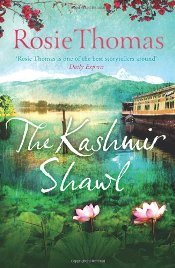 Multi-period novels with parallel stories linked by family connections are among my favorite types of books. While the parts set in an earlier time take me away from everyday concerns via unfamiliar settings and period-appropriate situations, the modern sections bring everything back home again, showing how people are more connected to history than they might have thought.
Multi-period novels with parallel stories linked by family connections are among my favorite types of books. While the parts set in an earlier time take me away from everyday concerns via unfamiliar settings and period-appropriate situations, the modern sections bring everything back home again, showing how people are more connected to history than they might have thought.A transporting story that begins in present-day North Wales and wends through the remote towns of India's Kashmir Valley during World War II, Rosie Thomas's The Kashmir Shawl offers enjoyable armchair escapism. I got it as a Christmas present and decided to read it in between the chunksters I had for review. Partway through I realized that, at 468 pages, it qualified as a chunkster as well.
Mair Ellis never knew her grandmother, Nerys Watkins, who died before she was born. After the death of their beloved father, Mair and her siblings discover a gorgeously patterned shawl hidden in an old chest of drawers. Made of the softest Indian wool, and full of wonderful colors and intricate detail, the shawl also conceals an envelope with a curl of dark brown hair that doesn't match anyone in their family.
This mystery proves an irresistible opportunity for Mair, who never knew much about her grandparents' time in India. Evan Watkins had been sent there as a Presbyterian missionary in the early '40s, and Nerys had willingly followed him there. In the hopes of uncovering their hidden history, Mair travels to the town of Leh, high in northwestern India's Himalayas. Her investigations into her grandmother's past and the shawl's origins eventually lead her to Srinigar, the summer capital of nearby Kashmir.
Mair and Nerys, whose journeys are revealed in alternating timelines, are independent, courageous, and also lonelier than they'd like to admit. Romantic, yet tempered with a good amount of realism, The Kashmir Shawl takes an honest look at many different aspects of love. This may sound trite, but one of the most impressive aspects of the novel is how its unstereotypical characters react to what's expected of them. While I never really warmed to Mair, I especially liked Nerys, who's left to fend for herself while her husband is off doing his godly work (and neither minds their separation as much as they should). She manages to balance her role as a proper clergyman's wife with a streak of unconventionality. Not all of her women friends fare as well.
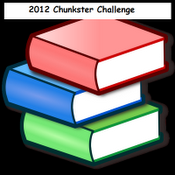 And as you can imagine, this is one of those epics where geography has a strong and vital presence. Srinigar, home to Dal Lake and its elaborate wooden houseboats, offers both beauty and conflict. In the 1940s, women of the British expatriate community hold social gatherings while their men are off at war, while the calm atmosphere of the modern-day town, as seen from Mair's viewpoint, is occasionally engulfed by Muslim-Hindu violence.
And as you can imagine, this is one of those epics where geography has a strong and vital presence. Srinigar, home to Dal Lake and its elaborate wooden houseboats, offers both beauty and conflict. In the 1940s, women of the British expatriate community hold social gatherings while their men are off at war, while the calm atmosphere of the modern-day town, as seen from Mair's viewpoint, is occasionally engulfed by Muslim-Hindu violence. Long-held traditions endure as well. In this age of mass production, it can be hard to fathom the years of effort that the novel's Kashmiri villagers pour into the weaving of a single shawl, but as Mair and Nerys discover, the end result is exquisite.
How the Kashmir shawl came to be in Nerys' possession isn't revealed until the book is nearly over, and it requires the introduction of a good many new characters, but the plot doesn't feel needlessly drawn out. I won't give more away than that, because getting there is an engrossing experience, and all of the strands pull together well at the end.
The Kashmir Shawl was published by HarperCollins UK in 2011 at £12.99 in trade paperback.
Published on January 28, 2012 11:28
January 26, 2012
And the Scott O'Dell winner is...
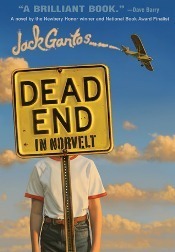 I confess I was paying so much attention to the Newberys and other ALA book awards that the announcement of the Scott O'Dell Award for Historical Fiction passed me by. This is an annual prize for a meritorious book for children or young adults (see the sponsor's website), and it comes with an award of $5000.
I confess I was paying so much attention to the Newberys and other ALA book awards that the announcement of the Scott O'Dell Award for Historical Fiction passed me by. This is an annual prize for a meritorious book for children or young adults (see the sponsor's website), and it comes with an award of $5000. As revealed on January 17th, the winner for 2012 is Jack Gantos' Dead End in Norvelt (FSG, 2011), which — yes — also took home the 2012 Newbery Medal. Read more at School Library Journal .
This morning, I opened up my issue of Shelf Awareness and found a fantastic, very funny interview with Gantos that you can find here (scroll 2/3 down the page). The novel's set during the summer of 1962, in Gantos's home town of Norvelt, Pennsylvania, a federally planned New Deal town named after Eleanor Roosevelt. The Q&A has some great discussion points on the nature of historical fiction, homestead communities, and using real people as characters.
A short quote from Jennifer M. Brown's interview:
JB: When you won the Scott O'Dell Award for Historical Fiction last week, we had to pause before realizing--ah yes, the setting is the summer of 1962, and it is historical fiction!Did you realize that if you go by the (somewhat arbitrary) definition that historical novels are set 50+ years in the past, that this now includes the early '60s? When I first started getting interested in the field, I remember talking to some readers my grandmother's age who were taken aback that WWII-era fiction was considered "historical." They lived through that era and remembered it well. Now that date range has moved ahead by a couple of decades.
JG: That's, let's see, exactly 50 years ago. I think you can get antique license plates for a 1962 car. Somebody said, "How does it feel to be given an award for a historical novel where you're the main character?" When you put it that way, I'm feeling a little crusty.
There are advantages to working in a library with a curriculum materials center. After reading about both awards, I searched in our online catalog to see whether we had a copy of Dead End in Norvelt - and we did! And it was available and on display with other award winners. So I grabbed it.
Published on January 26, 2012 07:00
January 24, 2012
Award-winning historical novels at ALA Midwinter, 2012
The American Library Association's 2012 Midwinter conference just wrapped up in Dallas, and a number of literary awards were announced there. Once again (see last year's list), historical fiction made a good showing.
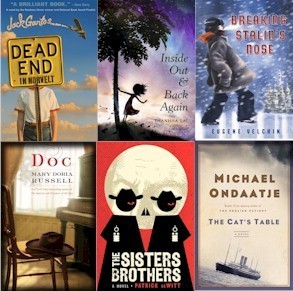
Relevant winners include:
The Newbery Medal and Newbery Honor books, recognizing the best in American children's literature.
- The winner: Jack Gantos' Dead End in Norvelt, an off-the-wall adventure set in small-town America in 1962;
- The Honor books: Thanhha Lai's Inside Out and Back Again, about a Vietnamese refugee family in the American South; and Eugene Yelchin's Breaking Stalin's Nose, middle-grade fiction set in Stalinist Russia.
The 2012 Reading List Awards, which recognize the best books in eight genres.
- For Historical Fiction: Mary Doria Russell's Doc, a reinterpretation of the life of Doc Holliday.
- On the Historical Fiction shortlist: Dominic Smith's Bright and Distant Shores , Amor Towles' Rules of Civility, Sharon Kay Penman's Lionheart, and Beth Powning's The Sea-Captain's Wife . [links to my reviews]
- For Fantasy, Erin Morgenstern's The Night Circus, a magical tale of lovers in a mysterious late 19th-century circus.
- For Romance, Loretta Chase's Silk is for Seduction, set in 1830s England.
ALA Notable Books, honoring excellent, important fiction for the adult reader. (Understood to be literary fiction; the Reading List looks at genre fiction.)
- Patrick deWitt, The Sisters Brothers, a darkly comic Western; and Michael Ondaatje's The Cat's Table, in which a young boy comes of age aboard ship in the 1950s. These were the only historical novels on the list; see the full slate for other honorees (including nonfiction and poetry).
~
On a personal note, I was notified of some very exciting news last Friday that was formally announced at ALA on Sunday night. The awards chair phoned me to say I'd been selected as the winner of the 2012 Louis Shores Award from the Reference & User Services Association, which is given for excellence in book reviewing for libraries. This blog was mentioned in the press release (how cool to have a press release of my own!).
Unfortunately I wasn't able to be at the conference in person ‒ I got word just after I'd finished up my afternoon reference desk shift at the library ‒ but there'll be an awards reception at the ALA Annual convention in Anaheim this summer, and I plan on being there. No big speeches here, but I was completely surprised and thrilled, and still am. A huge thanks to the librarian who nominated me and to the members of the award committee.

Relevant winners include:
The Newbery Medal and Newbery Honor books, recognizing the best in American children's literature.
- The winner: Jack Gantos' Dead End in Norvelt, an off-the-wall adventure set in small-town America in 1962;
- The Honor books: Thanhha Lai's Inside Out and Back Again, about a Vietnamese refugee family in the American South; and Eugene Yelchin's Breaking Stalin's Nose, middle-grade fiction set in Stalinist Russia.
The 2012 Reading List Awards, which recognize the best books in eight genres.
- For Historical Fiction: Mary Doria Russell's Doc, a reinterpretation of the life of Doc Holliday.
- On the Historical Fiction shortlist: Dominic Smith's Bright and Distant Shores , Amor Towles' Rules of Civility, Sharon Kay Penman's Lionheart, and Beth Powning's The Sea-Captain's Wife . [links to my reviews]
- For Fantasy, Erin Morgenstern's The Night Circus, a magical tale of lovers in a mysterious late 19th-century circus.
- For Romance, Loretta Chase's Silk is for Seduction, set in 1830s England.
ALA Notable Books, honoring excellent, important fiction for the adult reader. (Understood to be literary fiction; the Reading List looks at genre fiction.)
- Patrick deWitt, The Sisters Brothers, a darkly comic Western; and Michael Ondaatje's The Cat's Table, in which a young boy comes of age aboard ship in the 1950s. These were the only historical novels on the list; see the full slate for other honorees (including nonfiction and poetry).
~
On a personal note, I was notified of some very exciting news last Friday that was formally announced at ALA on Sunday night. The awards chair phoned me to say I'd been selected as the winner of the 2012 Louis Shores Award from the Reference & User Services Association, which is given for excellence in book reviewing for libraries. This blog was mentioned in the press release (how cool to have a press release of my own!).
Unfortunately I wasn't able to be at the conference in person ‒ I got word just after I'd finished up my afternoon reference desk shift at the library ‒ but there'll be an awards reception at the ALA Annual convention in Anaheim this summer, and I plan on being there. No big speeches here, but I was completely surprised and thrilled, and still am. A huge thanks to the librarian who nominated me and to the members of the award committee.
Published on January 24, 2012 19:19
January 23, 2012
An interview with Anne Clinard Barnhill, author of At the Mercy of the Queen
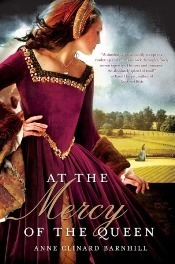
How far does family loyalty extend? If the relative to whom you owed your social position asked you a favor that required you to give up your innocence and a possible chance at love, would you do it?
In Anne Clinard Barnhill's first novel, Lady Margaret (Madge) Shelton, a young lady-in-waiting, is presented with this wrenching dilemma. Although she's in love with Arthur Brandon, a handsome courtier, Madge acquiesces when her cousin and queen, Anne Boleyn, asks her to catch the eye of Henry VIII. If King Henry is determined to take a mistress, Queen Anne thinks, best that it be someone loyal to her.
At the Mercy of the Queen follows Madge's transformation from a quiet and pretty country girl to a young woman who is considerably wiser in the ways of the world. Lady Margaret Shelton is a historical character, one of the three acknowledged mistresses of Henry VIII, and Anne Barnhill's perspective on her originated in an unexpected place: her own family tree. In a genre filled with novels about the scandalous Tudor court, Barnhill's novel stands out for its fresh viewpoint, its sumptuous descriptions of food and fashion, and a portrayal of the Anne Boleyn-Henry VIII relationship that felt especially realistic to this historical fiction reader.
I'd like to thank Anne for her willingness to do this interview and hope you'll enjoy it as well. As one of the more fun parts of her research, she's in the process of having a Tudor gown made. Pictures below!
Madge first makes an appearance as a young, sheltered girl from the country who isn't thrilled to leave her home and become lady-in-waiting to her cousin Anne. How did you sort through the few known facts about Madge's life to come up with her character?
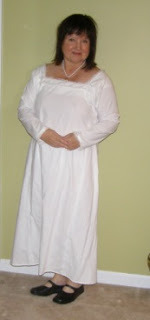 I've been reading about Madge for about 30 years, since I first discovered my connection to her. She is mentioned in most books about Henry VIII and Anne Boleyn. I also checked online and in a family history book I have (from my grandmother) which has about a paragraph about her. I found her family was involved in raising sheep for the wool industry and were somewhat prominent in Norfolk. Her father was sheriff and her ancestors built Shelton Hall. I began to imagine what things might have been like for her. As for her birth date, there is none I have been able to find. She was probably not quite as young as I have made her in the book, but she was younger than Anne Boleyn. I think the whole thing began when I started to consider what it would be like to have an affair with your cousin's husband. And, even more interesting, what if your cousin set the whole thing up? Why might she have done that and why might you agree?
I've been reading about Madge for about 30 years, since I first discovered my connection to her. She is mentioned in most books about Henry VIII and Anne Boleyn. I also checked online and in a family history book I have (from my grandmother) which has about a paragraph about her. I found her family was involved in raising sheep for the wool industry and were somewhat prominent in Norfolk. Her father was sheriff and her ancestors built Shelton Hall. I began to imagine what things might have been like for her. As for her birth date, there is none I have been able to find. She was probably not quite as young as I have made her in the book, but she was younger than Anne Boleyn. I think the whole thing began when I started to consider what it would be like to have an affair with your cousin's husband. And, even more interesting, what if your cousin set the whole thing up? Why might she have done that and why might you agree?In the novel, you portray Anne Boleyn sympathetically; she's ambitious and occasionally bad-tempered, but also gracious, dignified, and of a religious bent. She loves her husband and desperately wants her marriage to succeed. You mention that when you were 15, Anne Boleyn first captured your attention via Norah Lofts' The Concubine. What other sources, fiction or nonfiction, most influenced your portrayal of Queen Anne? Did The Concubine lead you to any other historical fiction discoveries?
I read mostly nonfiction for the first 20 years or so of my secret obsession. Eric Ives' work is wonderful. David Starkey, Alison Weir, Antonia Fraser, Warnicke, Dunn, just lots really. Then, I read all of Jean Plaidy, who I love. Philippa Gregory's The Other Boleyn Girl helped me out of the closet as I realized lots of people share my Tudor fascination. Online sources have been invaluable, though more for the second book than the first: the Anne Boleyn Files and On the Tudor Trail are great sources. I have not read as much historical fiction as I would like — I've discovered it rather late in my reading life. But I intend to change that and devour as much as I can find!
I especially loved your descriptions of the diversions and delicacies at the Tudor court: the dances, card games, sumptuous feasts, and so forth. Did you personally try out any of these things during the writing process? Which were the most enjoyable to write about?
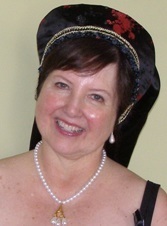 Oh, I love to write about food and fashion! I'm having a Tudor outfit made and thus far, I have the undergarments and a French hood to match the stomacher. I've selected material for the outer wear and hope to have that completed by the time the next book comes out. So, yes, I've experienced the clothing. As for the food, it's a little rich for my taste, though I may try some recipes this year, especially for drinks such as mulled wine. I will NOT try the dove stuffed into a duck stuffed into a goose stuffed into a peacock! That sounds really awful to me!
Oh, I love to write about food and fashion! I'm having a Tudor outfit made and thus far, I have the undergarments and a French hood to match the stomacher. I've selected material for the outer wear and hope to have that completed by the time the next book comes out. So, yes, I've experienced the clothing. As for the food, it's a little rich for my taste, though I may try some recipes this year, especially for drinks such as mulled wine. I will NOT try the dove stuffed into a duck stuffed into a goose stuffed into a peacock! That sounds really awful to me!Were there any scenes in the novel you found more challenging to write than others?
Well, I had pulled the curtain on most of the sex scenes and my agent wanted me to be more graphic. I loved writing them but they make me nervous when I think of people reading them. Really, I had fun writing the whole book — I started it to entertain myself... I really hadn't thought of trying to get it published. So I was very free to have fun!
Madge's nurse and friend, Cate, describes London as having the "scent of life." How do you get into the mindset for tuning out your current surroundings and writing about the bustle and intrigue of 16th-century London?
I go away so I can have solitude and then I read constantly from nonfiction books about the time and the people. I do have to dive in deep to get there and, once I get in, I really do not want to come out. That's why I go away — I'm not fit company for man nor beast. And I hope by surrounding myself with the books (I actually sleep with them piled across the bed, hoping to learn by osmosis I guess) I will get as real as possible.
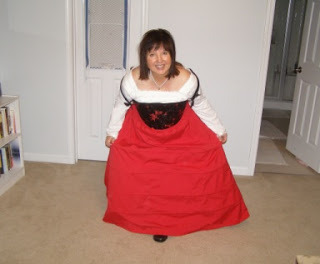
You mention in the preface that you've wanted to tell this story for thirty years. How did the idea of your novel change over time? Were there any new tidbits you discovered that took your story in a new direction from the way you initially imagined it?
I have always had the shape of the novel in my mind, pretty much as it is now. Madge turned out to be a little younger than I expected early on. I remember being a young teen and admiring older women, copying their mannerisms, their style — all of this as I was developing my own style. Young girls can almost worship an older woman they admire — I see this in my 9-year-old granddaughter as she encounters teens and young women in their 20's. I thought that would make the whole plot work better — having the relationship between Anne and Madge the primary relationship, thought there is a love interest for Madge, Arthur Brandon. He was a surprise--just turned up on the page cocky as you please. He definitely took the story in a different direction.
Your family connection to the Sheltons intrigues me, as it gives you a unique tie to your subject. Are you a descendant of Madge herself, or of one of her siblings? How did the Shelton Family History you mention as a source aid in your research?
I'm a descendant of Ralph Shelton, Madge's brother. The book is helpful in that it gives little paragraphs about those family members who have interesting stories or roles in history. For example, there are some Sheltons who married the Founding Fathers of the U.S. and that was interesting. Another relative led the Patriots at the Battle of King's Mountain — I just love all that stuff!
How have your experiences in evaluating other authors' work, as a writing tutor and book reviewer, influenced your own fiction writing?
Hmmm. I have slowly come to the idea that I want the writing to be as smooth as possible, so that the 'writer' never gets in the way of the story. I have not mastered that yet, and probably never will, but I want the story to flow, the dream to continue uninterrupted, as John Gardner puts it. It's easy to see mistakes in someone else's work, but incredibly hard to see it in your own. I think I've become a pretty good critic over the years but it's still hard to find my own stories--to get to the heart of the story. So, it definitely helps to look at what other folks are doing--and often, I am inspired by other writers. It's easy to stay in your own head until someone comes along and shakes you up. Then, you say, oh yeah! I could try that. Reading and writing go hand in hand.
~
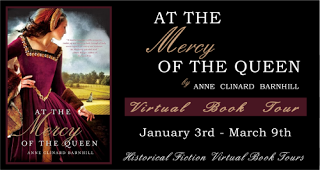
At the Mercy of the Queen was published by St. Martin's Griffin in January ($14.99/Can $16.99, trade paperback, 432pp + special reading group guide). This interview forms part of the Virtual Book Tour for At the Mercy of the Queen. For more information, see Anne Clinard Barnhill's website.
Published on January 23, 2012 05:00
January 19, 2012
Why I'm taking up the Chunkster Challenge

Did you ever notice that many historical novels are really, really long?
Above at left, we have over 4100 pages' worth of the latest in historical fiction; the shortest one - Madame Tussaud - barely qualifies for the challenge at 455 pages. And on the right we have Oliver, who insisted on being included in the pic. If he knew I'd be including him in a Chunkster Challenge post, he might have reconsidered (he's got a bit of a belly on him).
I seem to have accepted an awful lot of epics for review, so you'll be seeing them featured here over the next few months. Two books in the bunch are being cleverly hidden from view for now, because I've committed to reviewing them for other publications, but their identities will be revealed in time.
So this year, while I'm trying to work off a few extra pounds on the NordicTrack, I'll also be piling on the pages. I'm aiming for Plump Primer level (at least six chunksters) although I expect to surpass it. Let's not forget that the new Ken Follett, The Winter of the World, is set to be published in mid-September and is technically long enough to count as two chunksters (too bad it doesn't work that way).
I guess I'd better get reading.
Published on January 19, 2012 19:51
In which I give a tell-all interview
Okay, it's not quite that dramatic, but earlier this week, blogger and historical fiction fan Jane Steen asked me some good questions about the story behind my blog, trends in historical fiction, and other fun bookish and bloggish stuff. You can find it at: A Historical Fiction Book Blogger Tells All. Thanks, Jane, for the opportunity!
Published on January 19, 2012 17:26
January 17, 2012
Guest post from Julie Rose, author of Oleanna: Norway and Sweden in 1905
Today I'm welcoming Julie K. Rose to the blog to discuss the backdrop to her new historical novel, Oleanna, which takes place during the separation of Norway from Sweden in 1905. Oleanna, published this month, is based on people from her own family history. More details are available at oleannanovel.com. I'll be conducting an interview with Julie in a future post.
~
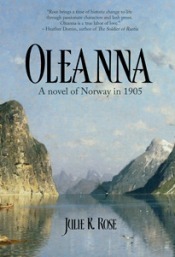 When you think of Norway (if you think of it at all), what comes to mind? Stunning scenery? Vikings? A successful socially liberal society? Hot blondes?
When you think of Norway (if you think of it at all), what comes to mind? Stunning scenery? Vikings? A successful socially liberal society? Hot blondes?
I expect the political separation of Norway and Sweden in 1905 wasn't high on your list. It hasn't exactly been a hot-button topic for historians, or for historical fiction authors. In fact, I'll wager most readers didn't realize that Norway and Sweden were ever joined, let alone separated. Here is a brief history of how the Dissolution of 1905 came to be.
Due to the geography of the area (tall mountains, deep fjords, a dearth of arable land, and over 25,000km of coastlines running from 58°N to more than 71°N) it was difficult to create a stable, agriculture-based economy and political structure beyond small kingdoms scattered throughout the country. The Viking Age saw increased wealth and the first attempts at a unified Norway under King Harald Fairhair. Later, the (often violent) promulgation of Christianity under King Olaf Haraldsson (St. Olav) from 1015-1028 allowed him to spread his political influence, unifying most of what we know as modern Norway. Despite a brief period under the dominion of Denmark's King Knut, Norway was ruled by Norwegians, including Harald Hardrada, Olaf's nephew (yes, the same Harald who died at Stamford Bridge in 1066), until 1299.In that year King Haakon V moved the capital to Oslo; upon his death, he had no sons, so the throne of Norway went to his daughter's son, King Magnus Eriksson of Sweden. King Magnus abdicated, and his son Haakon became king—he was married to Margrethe, the daughter of the Danish king, and so their son Olaf became king of Denmark in 1376 and Norway in 1380 as King Olav IV. (Got all that?)
Life continued on in Norway for hundreds of years, as the elite in Denmark ruled over Norway, and the Norwegian nobles couldn't seem to get their act together to make a run at independence. And then a strange thing happened.
In 1814, Denmark-Norway was defeated during the Napoleonic wars, and the king was forced to cede Norway to Sweden in the Treaty of Kiel. In an attempt to retain control, the Viceroy and hereditary prince of Denmark-Norway, Christian Frederik, encouraged the burgeoning independence movement ,and a constitutional convention and declaration of independence was made on May 17, 1814. This day is still celebrated in Norway as Syttende Mai (Seventeen May) or Constitution Day.
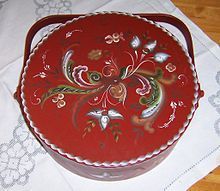 Rosemaling decorated with floral paintings
Rosemaling decorated with floral paintings
(source: Wikipedia)Sweden, of course, was having none of it and declared war on Norway. To keep the peace, Prince Christian Frederik relinquished his claims to the throne of Norway in return for a democratic Norwegian constitution. In return, the Norwegian parliament elected the Swedish king as King of Norway.
Suffice to say, the 91-year marriage of Norway and Sweden was not a particularly happy one; Norway tended to be liberal, parliamentary, and affiliated with the United Kingdom, while Sweden tended to be conservative, monarchial, and affiliated with Germany. Norway largely had political independence, but being yoked to rival Sweden was galling.
But one interesting thing did happen during this unhappy union: the reclamation of native folk art by the political movers and shakers. Folk art, like the graceful rosemaling, had never really died. Until well into the 20th century, many villages in Norway were extremely difficult to reach, and folk ways and art continued on as they always had.
As part of the general romantic nationalist movement in Europe during the 19th century, Norwegians rediscovered their art—the most famous examples of which are bunad, the traditional folk dress for each region of the country (which of course had never died out in most of the remote villages); and the folk tale collections of Asbjornson and Moe. Throughout the 19th century, Norwegians actively promoted pride in their country, in their art, in their culture—a useful fuel to fire what came next.
Matters came to a head in the 1890s, when Norway began to insist on its own consular offices abroad rather than common consuls appointed by Sweden. The Swedish government and king rejected this, which set in motion the events that would lead to the dissolution.
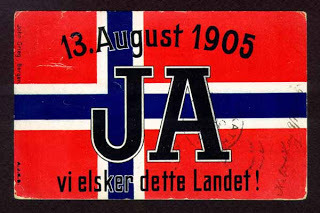 Propaganda poster from the summer of 1905:
Propaganda poster from the summer of 1905:
"We love our country!"
(Line from the national anthem, written in 1814)A coalition government was formed in 1905 to establish the separate Norwegian corps of consuls; the law was passed by the Storthing, but King Oscar II of Sweden refused to accept it, and the Norwegian coalition government resigned on June 7, 1905, declaring a dissolution of the union.
The Swedish government insisted on a Norwegian referendum to understand the citizen's view; it was held on August 13, and 99.95% of Norwegians voted in favor of dissolution. Though suffrage was not extended to women in national elections until 1913, Norwegian women still collected more than 200,000 signatures in favor of dissolution.
And so, Norwegians finally regained their independence for the first time since the 14th century. Or did they? In November another plebiscite was held in which 79% of Norwegians voted in favor of a monarchy and not a republic. This proved to be a challenge, because the hereditary lines of Norwegian kings were MIA. Who did Norway choose for its king? Oh, the irony: Prince Carl of Denmark. Carl took the name Haakon VII and, alongside his wife Maud of England, was sworn in as king on November 27, 1905. (Fun fact: the current King, Harald V, married commoner Sonja Haraldsen in 1968, the first Norwegian-born queen since Margrete Skulesdotter in 1225.)
So, what did it all mean for the people of Norway, this dissolution of the union? Norway emerged into the 20th century as an economic force to be reckoned with, growing wealthy through North Sea oil; the dissolution also brought Norway fully onto the world stage when it joined the League of Nations in 1920, and it solidified the alignment of Norway with Great Britain (which unfortunately would have terrible consequences for Norway during the world wars). Above all, though, the dissolution of 1905 gave the Norwegian people a renewed sense of pride, a fresh start in a new century. Their country had become an independent entity for the first time in 700 years. They were once again truly free.
~
Set during the separation of Norway from Sweden in 1905, Oleanna is a richly detailed novel of love and loss inspired by the life of the author's great-great-aunts.
Oleanna and her sister Elisabeth are the last of their family working their farm deep in the western fjordland. A new century has begun, and the world outside is changing, but in the Sunnfjord their world is as small and secluded as the verdant banks of a high mountain lake. With their parents dead and their brothers all gone to America, the sisters have resigned themselves to a simple life tied to the land and to the ghosts of those who have departed.
The arrival of Anders, a cotter living just across the farm's border, unsettles Oleanna's peaceful but isolated existence. Sharing a common bond of loneliness and grief, Anders stirs within her the wildness and wanderlust she has worked so hard to tame. When she is confronted with another crippling loss, Oleanna must decide once and for all how to face her past, claim her future, and find her place in a wide new world.
Julie K. Rose is an author of historical and mainstream fiction with a touch of the fantastic. She lives in the Bay Area and loves reading (especially Patrick O'Brian), watching episodes of Doctor Who, and enjoying the amazing natural beauty of Northern California. Oleanna is her second novel.
~
 When you think of Norway (if you think of it at all), what comes to mind? Stunning scenery? Vikings? A successful socially liberal society? Hot blondes?
When you think of Norway (if you think of it at all), what comes to mind? Stunning scenery? Vikings? A successful socially liberal society? Hot blondes?I expect the political separation of Norway and Sweden in 1905 wasn't high on your list. It hasn't exactly been a hot-button topic for historians, or for historical fiction authors. In fact, I'll wager most readers didn't realize that Norway and Sweden were ever joined, let alone separated. Here is a brief history of how the Dissolution of 1905 came to be.
Due to the geography of the area (tall mountains, deep fjords, a dearth of arable land, and over 25,000km of coastlines running from 58°N to more than 71°N) it was difficult to create a stable, agriculture-based economy and political structure beyond small kingdoms scattered throughout the country. The Viking Age saw increased wealth and the first attempts at a unified Norway under King Harald Fairhair. Later, the (often violent) promulgation of Christianity under King Olaf Haraldsson (St. Olav) from 1015-1028 allowed him to spread his political influence, unifying most of what we know as modern Norway. Despite a brief period under the dominion of Denmark's King Knut, Norway was ruled by Norwegians, including Harald Hardrada, Olaf's nephew (yes, the same Harald who died at Stamford Bridge in 1066), until 1299.In that year King Haakon V moved the capital to Oslo; upon his death, he had no sons, so the throne of Norway went to his daughter's son, King Magnus Eriksson of Sweden. King Magnus abdicated, and his son Haakon became king—he was married to Margrethe, the daughter of the Danish king, and so their son Olaf became king of Denmark in 1376 and Norway in 1380 as King Olav IV. (Got all that?)
Life continued on in Norway for hundreds of years, as the elite in Denmark ruled over Norway, and the Norwegian nobles couldn't seem to get their act together to make a run at independence. And then a strange thing happened.
In 1814, Denmark-Norway was defeated during the Napoleonic wars, and the king was forced to cede Norway to Sweden in the Treaty of Kiel. In an attempt to retain control, the Viceroy and hereditary prince of Denmark-Norway, Christian Frederik, encouraged the burgeoning independence movement ,and a constitutional convention and declaration of independence was made on May 17, 1814. This day is still celebrated in Norway as Syttende Mai (Seventeen May) or Constitution Day.
 Rosemaling decorated with floral paintings
Rosemaling decorated with floral paintings(source: Wikipedia)Sweden, of course, was having none of it and declared war on Norway. To keep the peace, Prince Christian Frederik relinquished his claims to the throne of Norway in return for a democratic Norwegian constitution. In return, the Norwegian parliament elected the Swedish king as King of Norway.
Suffice to say, the 91-year marriage of Norway and Sweden was not a particularly happy one; Norway tended to be liberal, parliamentary, and affiliated with the United Kingdom, while Sweden tended to be conservative, monarchial, and affiliated with Germany. Norway largely had political independence, but being yoked to rival Sweden was galling.
But one interesting thing did happen during this unhappy union: the reclamation of native folk art by the political movers and shakers. Folk art, like the graceful rosemaling, had never really died. Until well into the 20th century, many villages in Norway were extremely difficult to reach, and folk ways and art continued on as they always had.
As part of the general romantic nationalist movement in Europe during the 19th century, Norwegians rediscovered their art—the most famous examples of which are bunad, the traditional folk dress for each region of the country (which of course had never died out in most of the remote villages); and the folk tale collections of Asbjornson and Moe. Throughout the 19th century, Norwegians actively promoted pride in their country, in their art, in their culture—a useful fuel to fire what came next.
Matters came to a head in the 1890s, when Norway began to insist on its own consular offices abroad rather than common consuls appointed by Sweden. The Swedish government and king rejected this, which set in motion the events that would lead to the dissolution.
 Propaganda poster from the summer of 1905:
Propaganda poster from the summer of 1905: "We love our country!"
(Line from the national anthem, written in 1814)A coalition government was formed in 1905 to establish the separate Norwegian corps of consuls; the law was passed by the Storthing, but King Oscar II of Sweden refused to accept it, and the Norwegian coalition government resigned on June 7, 1905, declaring a dissolution of the union.
The Swedish government insisted on a Norwegian referendum to understand the citizen's view; it was held on August 13, and 99.95% of Norwegians voted in favor of dissolution. Though suffrage was not extended to women in national elections until 1913, Norwegian women still collected more than 200,000 signatures in favor of dissolution.
And so, Norwegians finally regained their independence for the first time since the 14th century. Or did they? In November another plebiscite was held in which 79% of Norwegians voted in favor of a monarchy and not a republic. This proved to be a challenge, because the hereditary lines of Norwegian kings were MIA. Who did Norway choose for its king? Oh, the irony: Prince Carl of Denmark. Carl took the name Haakon VII and, alongside his wife Maud of England, was sworn in as king on November 27, 1905. (Fun fact: the current King, Harald V, married commoner Sonja Haraldsen in 1968, the first Norwegian-born queen since Margrete Skulesdotter in 1225.)
So, what did it all mean for the people of Norway, this dissolution of the union? Norway emerged into the 20th century as an economic force to be reckoned with, growing wealthy through North Sea oil; the dissolution also brought Norway fully onto the world stage when it joined the League of Nations in 1920, and it solidified the alignment of Norway with Great Britain (which unfortunately would have terrible consequences for Norway during the world wars). Above all, though, the dissolution of 1905 gave the Norwegian people a renewed sense of pride, a fresh start in a new century. Their country had become an independent entity for the first time in 700 years. They were once again truly free.
~
Set during the separation of Norway from Sweden in 1905, Oleanna is a richly detailed novel of love and loss inspired by the life of the author's great-great-aunts.
Oleanna and her sister Elisabeth are the last of their family working their farm deep in the western fjordland. A new century has begun, and the world outside is changing, but in the Sunnfjord their world is as small and secluded as the verdant banks of a high mountain lake. With their parents dead and their brothers all gone to America, the sisters have resigned themselves to a simple life tied to the land and to the ghosts of those who have departed.
The arrival of Anders, a cotter living just across the farm's border, unsettles Oleanna's peaceful but isolated existence. Sharing a common bond of loneliness and grief, Anders stirs within her the wildness and wanderlust she has worked so hard to tame. When she is confronted with another crippling loss, Oleanna must decide once and for all how to face her past, claim her future, and find her place in a wide new world.
Julie K. Rose is an author of historical and mainstream fiction with a touch of the fantastic. She lives in the Bay Area and loves reading (especially Patrick O'Brian), watching episodes of Doctor Who, and enjoying the amazing natural beauty of Northern California. Oleanna is her second novel.
Published on January 17, 2012 06:00
January 14, 2012
Winner of 2011 Langum Prize for American Historical Fiction
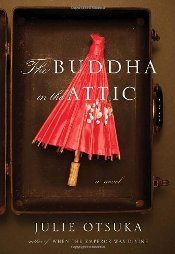 Julie Otsuka's The Buddha in the Attic (Knopf) is the winner of the Langum Prize for American Historical Fiction for 2011.
Julie Otsuka's The Buddha in the Attic (Knopf) is the winner of the Langum Prize for American Historical Fiction for 2011. From the press release: "This short, poetic book describes the experience of the Japanese 'picture brides' who were brought over in the very early part of the 20th century to marry Japanese men working in the United States, mostly as farm laborers. The writing is beautiful, and, although the book is sparse, each word carries weight."
Geraldine Brooks' Caleb's Crossing (Viking) was named an Honorable Mention:
"The mid-seventeenth century Massachusetts of Martha's Vineyard and Cambridge provide the settings for this exquisitely and lushly written novel that explores the clash of cultures between the Puritans and the native Wampanoag inhabitants."
 Five novels received a Director's Mention this year, which reflects and recognizes the number of quality submissions the award received from small and regional presses. They are as follows:
Five novels received a Director's Mention this year, which reflects and recognizes the number of quality submissions the award received from small and regional presses. They are as follows:John M. Archer, After the Rain: A Novel of War and Coming Home (Ten Roads Publishing): Following the Civil War, a wounded Union officer returns home, plagued by guilt over his comrades' deaths.
James Hoggard, The Mayor's Daughter (Wings Press): In small-town Texas during the 1920s oil boom, a young woman and her family sit at odds over her choice of husband.
Hugh Nissenson, The Pilgrim (Sourcebooks): A Calvinist arrives in Massachusetts from England in 1622 and is consumed by spiritual conflict.
Sheila Ortiz-Taylor, Homestead (Spinsters Ink): A large lower middle-class family undergoes change in 1920s and 1930s Florida and Georgia.
Shirley Reva Vernick, The Blood Lie (Cinco Puntos Press): In this young adult novel, based on an actual incident in 1920s small-town upstate New York, a young Jewish boy is accused of murdering a young girl, who had become lost but was quite alright, for the use in supposed religious ceremonies.

For more details on these titles as well as the awards submission process, see the Langum Charitable Trust website. Descriptions for these titles are based on the press release.
Published on January 14, 2012 17:00



